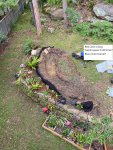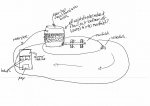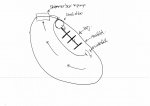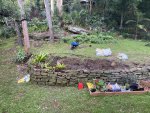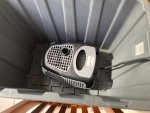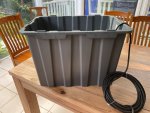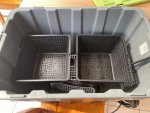Hi all,
Thanks to the great advice from you guys regarding my last plan I have ditched it and gone for a more traditional plan. However, I would love some advice again please.
The primary thing I am after is a self contained pond that doesn't need me to drain it and clean it out. I keep reading about people having to drain their pond every 2-3 years and that sounds like a horrendous task. So I'm keen to do whatever I need to do to avoid that. I also don't want to have to use a vacuum cleaner to suck up the gunk off the bottom. I am keen to build it so it keeps itself clean without my intervention (or very minor intervention).
The plan is to have a good percentage of the pond surface area dedicated to a bog. Perhaps 25% surface area and 12 inches deep with 1cm pea gravel (1/2 inch approximate). I'm assuming pea gravel is this stuff? We call it river gravel here in Oz: https://anlscape.com.au/Products/gravels-pebbles/nepean-river-pebble-10mm
The pond is underneath a massive 50 meter (150ft) Ghost Gum tree, with other gum trees around. They are evergreen but they still drop some leaves and lots of bark in summer. So I am going to end up with some leaves and bark in the pond. I'll get most of the big pieces of bark manually (some pieces are massive) but smaller bits will sink too fast, and leaves will also sink sometimes.
I have already bought a 4900Lph pump - Messner Eco x2 4500 (I hope it's enough! I'd like to just need 1 pump) https://lovemypond.com.au/product/messner-eco-x2-4500-filtration-waterfall-pump/
I have also bought a piece of Firestone 7.5m x 6.1m (25ft x 20ft).
The position I have to build it is a weird bit of land on top of a stone retaining wall. The wall is not mortared, but it is stable. However, I cannot dig too deep or the pressure from the water will push out and put pressure on the retaining wall. For that reason I am going down a small distance into the ground, but a lot of my pond depth is coming from building embankments (which I will then build a second retaining wall around to make pretty). That way the pond will be sitting primarily "ON TOP" of the ground with weight pushing down, rather than sitting "IN" the ground and weight pushing outwards. It might make more sense looking at the photos attached.
The pond is relatively small. I've worked out the approximate liters and it is between 4000L and 5000L (which is a bit over 1000 gallons). Of that, around 500L is bog. The deepest spot is currently planned to be about 2 feet deep, essentially a 2 foot channel through the main pond. That may get a bit larger or deeper, if I have to build systems into the design to keep it clean, but unfortunately it's not feasible for me to build a much larger pond at the moment. I could maybe go down another half a foot, or 1 foot in places. And maybe a bit wider. But I'm limited by wife-not-letting-me-use-all-the-grass (fair enough). I'm also limited by the size of embankment that I can reasonably build. They can't be oppressively large. If I need more volume to get better filtration going then I can dig it out some more, within reason (and within the scope of my Firestone sheet).
So really, my questions come down to:
- How do I stop the bottom of the pond filling up with muck and gunk that I have to drain the pond to clean?
- How do I stop the bottom of the bog filling up with muck and gunk that I have to drain to clean?
- Does this plan look like it will work?
- What stupid mistakes am I making this time please?
Options that I have been considering (added to the bog and working with the bog)
- A manifold intake system on the bottom of the pond (just down the deepest end), to suck in gunk and muck from the bottom. I have seen this used a lot in koi pond builds. It's like a manifold you might use in the bog, but with bigger holes. Then you put a layer of 75-150mm (3 inch to 5 inch) river pebbles in the bottom of the pond to cover the manifold. The manifold then sucks all the muck up from the bottom of the pond and dumps it into the bog. However, then you have a mucky bog. Does the bog clean muck and gunk? Or does it just take the nutrients from the water?
- A home made skimmer to suck some of the leaves off the top before they sink. But I'll still be left with a ton of muck on the bottom of the pond won't I? And if I put my pump inside the skimmer, then can I suck the entire volume of the pond through the skimmer every hour? I could conceivably build a splitter so the pump sucks from the skimmer and also from the bottom of the pond? But even then, would that just dump all the muck into the bog and turn that into a muck pit?
- A barrel of bio balls (open top or airtight and pressurized?) that the pump sends the water through first, the thinking being that the gunk will primarily pool in the barrel and then I can flush the barrel out periodically, avoiding having to clean out the pond. Ie, the pump at the lowest point in the pond where it will suck up the most gunk, then that goes into the barrel, then that into the bog. However, there is then issues of the nutrients being filtered in the barrel, because the bog needs those nutrients for the plants.
- Or just an empty box that the water passes through first, that has a grate or netting to catch the gunk?
- Or do I just make a bog, put the pump in the bottom of the pond so it sucks up all the gunk, and then the bog will deal with that gunk and break it down? That would be fabulous. I'd love to just have a bog and nothing else. But several people I have spoken with have said that you need some additional system to get the gunk out, otherwise I'll need to clean it out all the time. A bigger bog?
- I'm not keen on the idea of using a pond vacuum. I'd rather keep it filtered naturally if possible.
Anyway, I hope that makes sense. I'm not averse to there being the usual layer of algae and sediment in the bottom of the pond, but I know from ponds my mother had when I was a kid that the sediment can quickly build up into something foul, and I want to avoid that.
Attached are some photos of the site and a couple of sketches of the layout plan.
The top down view shows the current state of the pond. You can see the main retaining wall at the lower toe of the pond with the black cloth holding it in place for the time being. I will be building that retaining wall all around the pond, and up to an equal level. The bog will be in a separate pool higher than the main pool, but all using the same piece of liner.
The other photo shows the wall from ground level. You can also see the slope of the land (which is another reason for the retaining wall, to level the pond area). That was taken a few weeks ago though, and I haven't started the retaining wall yet.
I can take some more photos tomorrow if that would help at all.
Anyway, sorry for the essay! Ha. Any help or advice would be very much appreciated! Cheers
Thanks to the great advice from you guys regarding my last plan I have ditched it and gone for a more traditional plan. However, I would love some advice again please.
The primary thing I am after is a self contained pond that doesn't need me to drain it and clean it out. I keep reading about people having to drain their pond every 2-3 years and that sounds like a horrendous task. So I'm keen to do whatever I need to do to avoid that. I also don't want to have to use a vacuum cleaner to suck up the gunk off the bottom. I am keen to build it so it keeps itself clean without my intervention (or very minor intervention).
The plan is to have a good percentage of the pond surface area dedicated to a bog. Perhaps 25% surface area and 12 inches deep with 1cm pea gravel (1/2 inch approximate). I'm assuming pea gravel is this stuff? We call it river gravel here in Oz: https://anlscape.com.au/Products/gravels-pebbles/nepean-river-pebble-10mm
The pond is underneath a massive 50 meter (150ft) Ghost Gum tree, with other gum trees around. They are evergreen but they still drop some leaves and lots of bark in summer. So I am going to end up with some leaves and bark in the pond. I'll get most of the big pieces of bark manually (some pieces are massive) but smaller bits will sink too fast, and leaves will also sink sometimes.
I have already bought a 4900Lph pump - Messner Eco x2 4500 (I hope it's enough! I'd like to just need 1 pump) https://lovemypond.com.au/product/messner-eco-x2-4500-filtration-waterfall-pump/
I have also bought a piece of Firestone 7.5m x 6.1m (25ft x 20ft).
The position I have to build it is a weird bit of land on top of a stone retaining wall. The wall is not mortared, but it is stable. However, I cannot dig too deep or the pressure from the water will push out and put pressure on the retaining wall. For that reason I am going down a small distance into the ground, but a lot of my pond depth is coming from building embankments (which I will then build a second retaining wall around to make pretty). That way the pond will be sitting primarily "ON TOP" of the ground with weight pushing down, rather than sitting "IN" the ground and weight pushing outwards. It might make more sense looking at the photos attached.
The pond is relatively small. I've worked out the approximate liters and it is between 4000L and 5000L (which is a bit over 1000 gallons). Of that, around 500L is bog. The deepest spot is currently planned to be about 2 feet deep, essentially a 2 foot channel through the main pond. That may get a bit larger or deeper, if I have to build systems into the design to keep it clean, but unfortunately it's not feasible for me to build a much larger pond at the moment. I could maybe go down another half a foot, or 1 foot in places. And maybe a bit wider. But I'm limited by wife-not-letting-me-use-all-the-grass (fair enough). I'm also limited by the size of embankment that I can reasonably build. They can't be oppressively large. If I need more volume to get better filtration going then I can dig it out some more, within reason (and within the scope of my Firestone sheet).
So really, my questions come down to:
- How do I stop the bottom of the pond filling up with muck and gunk that I have to drain the pond to clean?
- How do I stop the bottom of the bog filling up with muck and gunk that I have to drain to clean?
- Does this plan look like it will work?
- What stupid mistakes am I making this time please?
Options that I have been considering (added to the bog and working with the bog)
- A manifold intake system on the bottom of the pond (just down the deepest end), to suck in gunk and muck from the bottom. I have seen this used a lot in koi pond builds. It's like a manifold you might use in the bog, but with bigger holes. Then you put a layer of 75-150mm (3 inch to 5 inch) river pebbles in the bottom of the pond to cover the manifold. The manifold then sucks all the muck up from the bottom of the pond and dumps it into the bog. However, then you have a mucky bog. Does the bog clean muck and gunk? Or does it just take the nutrients from the water?
- A home made skimmer to suck some of the leaves off the top before they sink. But I'll still be left with a ton of muck on the bottom of the pond won't I? And if I put my pump inside the skimmer, then can I suck the entire volume of the pond through the skimmer every hour? I could conceivably build a splitter so the pump sucks from the skimmer and also from the bottom of the pond? But even then, would that just dump all the muck into the bog and turn that into a muck pit?
- A barrel of bio balls (open top or airtight and pressurized?) that the pump sends the water through first, the thinking being that the gunk will primarily pool in the barrel and then I can flush the barrel out periodically, avoiding having to clean out the pond. Ie, the pump at the lowest point in the pond where it will suck up the most gunk, then that goes into the barrel, then that into the bog. However, there is then issues of the nutrients being filtered in the barrel, because the bog needs those nutrients for the plants.
- Or just an empty box that the water passes through first, that has a grate or netting to catch the gunk?
- Or do I just make a bog, put the pump in the bottom of the pond so it sucks up all the gunk, and then the bog will deal with that gunk and break it down? That would be fabulous. I'd love to just have a bog and nothing else. But several people I have spoken with have said that you need some additional system to get the gunk out, otherwise I'll need to clean it out all the time. A bigger bog?
- I'm not keen on the idea of using a pond vacuum. I'd rather keep it filtered naturally if possible.
Anyway, I hope that makes sense. I'm not averse to there being the usual layer of algae and sediment in the bottom of the pond, but I know from ponds my mother had when I was a kid that the sediment can quickly build up into something foul, and I want to avoid that.
Attached are some photos of the site and a couple of sketches of the layout plan.
The top down view shows the current state of the pond. You can see the main retaining wall at the lower toe of the pond with the black cloth holding it in place for the time being. I will be building that retaining wall all around the pond, and up to an equal level. The bog will be in a separate pool higher than the main pool, but all using the same piece of liner.
The other photo shows the wall from ground level. You can also see the slope of the land (which is another reason for the retaining wall, to level the pond area). That was taken a few weeks ago though, and I haven't started the retaining wall yet.
I can take some more photos tomorrow if that would help at all.
Anyway, sorry for the essay! Ha. Any help or advice would be very much appreciated! Cheers
Attachments
Last edited:


